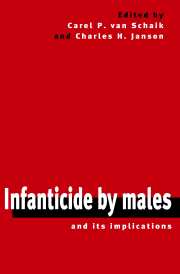Book contents
- Frontmatter
- Contents
- List of Contributors
- Foreword
- Infanticide by males: prospectus
- Part I Introduction
- Part II Infanticide by males: case studies
- Part III Behavioral consequences of infanticide by males
- 10 Prevention of infanticide: the perspective of infant primates
- 11 Infanticide and the evolution of male–female bonds in animals
- 12 The other side of the coin: infanticide and the evolution of affiliative male–infant interactions in Old World primates
- 13 Female dispersal and infanticide avoidance in primates
- 14 Reproductive patterns in eutherian mammals: adaptations against infanticide?
- 15 Paternity confusion and the ovarian cycles of female primates
- 16 Social evolution in primates: the relative roles of ecology and intersexual conflict
- Part IV Infanticide by females
- Part V Conclusion
- References
- Species index
- Subject index
14 - Reproductive patterns in eutherian mammals: adaptations against infanticide?
Published online by Cambridge University Press: 04 November 2009
- Frontmatter
- Contents
- List of Contributors
- Foreword
- Infanticide by males: prospectus
- Part I Introduction
- Part II Infanticide by males: case studies
- Part III Behavioral consequences of infanticide by males
- 10 Prevention of infanticide: the perspective of infant primates
- 11 Infanticide and the evolution of male–female bonds in animals
- 12 The other side of the coin: infanticide and the evolution of affiliative male–infant interactions in Old World primates
- 13 Female dispersal and infanticide avoidance in primates
- 14 Reproductive patterns in eutherian mammals: adaptations against infanticide?
- 15 Paternity confusion and the ovarian cycles of female primates
- 16 Social evolution in primates: the relative roles of ecology and intersexual conflict
- Part IV Infanticide by females
- Part V Conclusion
- References
- Species index
- Subject index
Summary
Introduction
Although all female eutherian mammals share the same basic reproductive physiology, they show great variation in their sexual behavior (van Tienhoven 1983; Short 1984; Flowerdew 1987). In some families, especially among primates, females can mate over a period of weeks and may actively pursue polyandrous mating, whereas in others, for example some bovids, females restrict sexual behavior to a single mating with a single male per conception. Likewise, females of some species regularly mate while pregnant, whereas in most others mating stops upon fertilization. Details of the regulation of ovarian cycles also vary greatly. For example, in the ovarian cycles of many carnivores, extensive stimulation by mating is required for ovulation to occur (known as induced ovulation), whereas in many rodents ovulation is spontaneous but mating induces the formation of the corpus luteum; in primates, in contrast, the whole cycle proceeds spontaneously regardless of whether any mating occurs.
Traditionally, such variation in ovarian cycles and sexual behavior has been regarded as a feature that reflected merely evolutionary history rather than current function. Reproduction is critical to fitness, however, and, increasingly, adaptive explanations are sought for these variations in sexual behavior, its regulation and other features of reproduction (e.g., Eberhard 1996). Ever since Hrdy's (1977, 1979) research, it has been argued that some features of sexual behavior are best considered an adaptive counterstrategy to the threat of infanticide by males.
- Type
- Chapter
- Information
- Infanticide by Males and its Implications , pp. 322 - 360Publisher: Cambridge University PressPrint publication year: 2000
- 52
- Cited by

